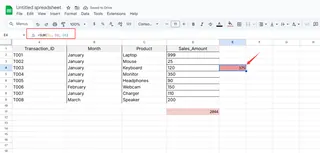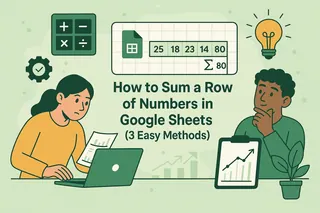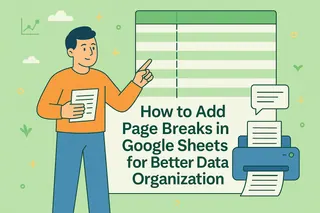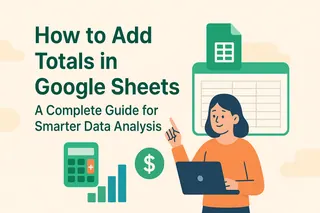Let's be real - we've all been there. Staring at a spreadsheet full of numbers, trying to add them up without missing anything. Whether you're tracking expenses, analyzing sales, or just trying to make sense of your data, knowing how to sum columns quickly is a game-changer.
Here's the good news: Google Sheets makes this super easy once you know the tricks. Even better? AI tools like Excelmatic can automate the whole process for you. Let's dive in.
The Classic: SUM Function (Your Spreadsheet BFF)
The SUM function is like that reliable friend who always shows up when you need them. Here's how to use it:
- Click where you want your total to appear
- Type
=SUM(then highlight your column (like A1:A5) - Hit Enter - boom, instant total

Pro tip: This works best when your numbers are in a neat, continuous column. But what if they're scattered everywhere? No sweat.
The Flexible Approach: Adding Non-Adjacent Cells
Got numbers playing hide-and-seek across your sheet? Here's how to catch them all:
=SUM(D1,D3,D5)

Just list each cell you want to include, separated by commas. It's like creating your own math scavenger hunt.
The Speedster Method: AutoSum
Short on time? The AutoSum button (that fancy Σ symbol) is your new best friend:
- Click where you want the total
- Hit the Σ button
- Sheets guesses the range (check if it's right)
- Press Enter
This is perfect when you're in a hurry and working with obvious number columns.
Level Up: ArrayFormula for Power Users
When you need to add columns row by row (like totaling each line item), ArrayFormula is magic:
=ArrayFormula(A1:A + B1:B)
This creates a running total in a new column. It looks fancy, but once you try it, you'll wonder how you lived without it.
The Smart Way: Conditional Sums with SUMIF/SUMIFS
Want to only sum certain items? These functions are life-savers:
SUMIF (single condition):
=SUMIF(B:B, "Marketing", A:A)
(Adds column A where column B says "Marketing")SUMIFS (multiple conditions):
=SUMIFS(A:A, B:B, "Marketing", C:C, "Q1")
(Only Marketing team's Q1 numbers)
The Future of Spreadsheets: Let AI Do the Math
Here's where things get really interesting. While these formulas are great, why type them at all? With Excelmatic, you can:
- Automatically detect and sum columns with AI
- Get smart suggestions for the right formulas
- Create dynamic totals that update as your data changes
- Generate complete reports with totals in seconds
Instead of memorizing formulas, just describe what you need. Excelmatic's AI understands requests like "sum all sales by region" or "show monthly expense totals" and builds the perfect formulas for you.
Pro Tips for Smarter Sums
- Name your ranges - Makes formulas easier to read and maintain
- Double-check ranges - Avoid missing cells or including headers
- Use tables - Makes your sums automatically expand with new data
- Try AI first - Tools like Excelmatic often find better ways to calculate
Wrapping Up: From Basic Math to AI Magic
Mastering column sums in Google Sheets gives you serious spreadsheet power. Whether you're using simple SUM functions or advanced conditional formulas, these skills will save you hours.
But here's the real secret: the future is AI-powered analysis. While learning these formulas is valuable, tools like Excelmatic are changing the game by automating the busywork. Why type formulas when AI can write them for you?
Try combining these manual methods with smart AI tools, and you'll become unstoppable at data analysis. Your future self (and your boss) will thank you.
Want to skip the formulas altogether? See how Excelmatic can automate your spreadsheet math. It's like having a data assistant who never sleeps.






